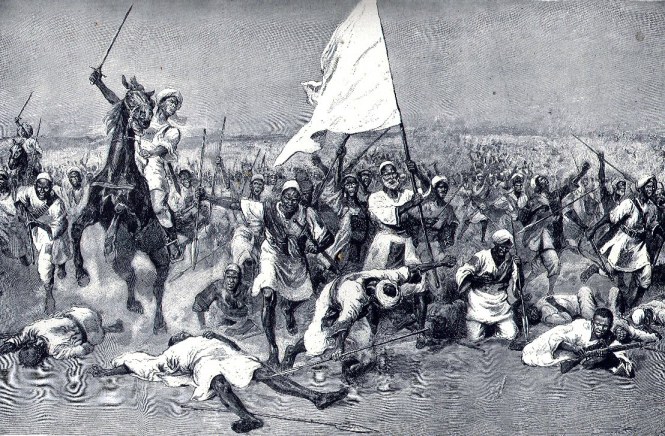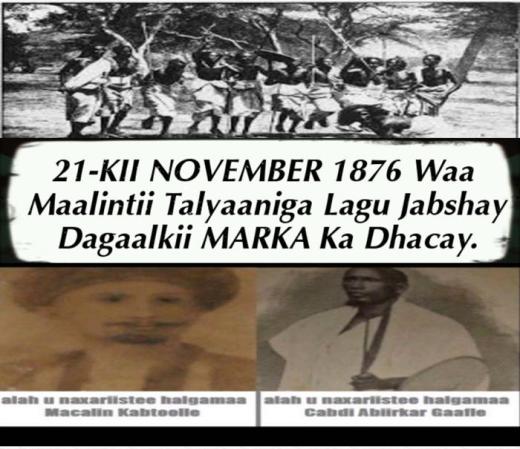Marka’s anti-colonial struggle
Reer Jannah waa jid galeen.
Reer Jahanama iska jooga.
Those who fight are bound for Heaven
Those who submit can stay in Hell
“It is necessary for the government to assert itself materially and morally over the populations surrounding the Banadir stations … and … gradually undertake the peaceful penetration of the interior and extend our direct administration to the line of the Shabelle River”.
Merca: Caratteristica Cittadina Contesaci, Per Vari Anni, In Aspri Combattimenti Dalle Belligere Tribu Bimal
- Italian News depicting the Bimaal Revolt in Images


21-KII NOVEMBER 1876-DII WAXAY KU BEEGAN TAHAY MARKII GUMEYSIGII TALYAANIGA XEEBTA MAGAAALADA MARKA CADEEY LAGU JABIYEY.
Dagaalyahano ka tirsan beesha Biimaal oo ay horkacayeen labaddii hogaamiye ee xiligaasi ugu caansanaa oo kala ahaa Allah u naxariistee Macalim Kabtooli iyo Sh Cabdi Abiikar Gaafle ayaa difaacyo adag waxa ay ka sameysteen xeebaha magaalada Marka si ay ugu hortagaan gumeysigii Talyaaniga oo doonayey inay cagta soo dhigaan dhulkii ay ka talineysay Saldanadii Beesha Biimaal. Gumeysigii Talyaaniga oo adeegsanayey xeeladihii military ee xiligaasi ugu casrisanaa waxa ay weerarkooda magaalada Marka ku soo qaadeen kaga yimaadeen laba aag.
Dhinaca xeebta oo maraakiibta dagaalka madaafiic ku soo garaacayey magaalada ka dibna ciidamo boqolaal ku soo daadiyey xeebta iyo dhinaca beriga oo ay ka soo galeen dhinaca magaalada Muqdisho. Shir deg deg ah duhurnimadii 21- November 1902 waxa isugu yimid deegaanka Hareerley (Hareerley waxay aheyd xaruntii ugu weyneed ee taliska ciidmada Biimaal) hogaamiyaashii beesha Biimaal waxa ayna isla qaateen dagaal loogu hortago gumeysiga dhulkooda soo galay. isla maalintaas waxa ciidamo loo kala diray xeebaha magaalada Marka iyo deegaanka Lafoole si loo hor istaago ciidamadii gumeysiga. waxaana halkaani si buuxda ugu bilowday dagaalkii mudda dheer socday ee loo yaqiinay “THE BIIMAAL REVOLT”Buugaag taariikhda dagaaladaasi ka hadlaya ayaa laga qoray oo maanta laga heli karo Libraryada dunida. Waxa xusid mudan sida wararku aan ku heleyno in maanta magaalada Marka shir ay isugu yimaadeen Golaha Guurtida Beesha Biimaal ay kaga hadlayeen xuskani, iyaga oo ka codsaday maamulka magaalada Marka Cadeey in waxii maanta ka bilowda 21 November loo aqoonsado maalin Qaran oo lagu xusayo halyeeyadii dalka u soo dhintay. Iyaga oo Guurtida Biimaal isku raacay si gaar ah deegnada beesha Biimaal laga xuso maalinkan taariikhiga ah. waxa ayna isku raaceen in Schoolada deegaanka gaar ahaan magaalada Marka la fasaxo sanadkasta 21 November si jiilka cusub loo baro taariikhda ay leeyihiin.
Halkan hoose ka daawo siyaasi Dr Saadaq Eenow oo ah aqoonyahan Soomaaliyeed oo ku takhasusay cilmiga caafimaadka, PHd-na ka sameeyey history-ga isaga oo ka hadlaya dagaalkii Biimaal iyo Talyaaniga:
Dagaalkaas intii uu socday taariikhihii ugu caansanaa waxa ka mid ah
Reer jannow waa jidgaleen === People of heaven, have found their way.
Reer jaxiimow iska jooga ==== people of hell, stay where you are.
Sep. 1904 Waxa Cigale iyo agagaarka Markaba qabsaday Talyaaniga; wuxuuna Cigale ka dhistay Sariibad. Ka dib marki Cigale Talyaaniga qabsaday hogaamiyaashii Biimaal waxa ay isugu tageen magaalada Mooyaale (Galbeedka Laantabuuro) si ay xaalada cusub ee soo korortay ugu wada tashan lahaayeen.
Intii aan Cigale laga qabsan, Biimaal waxa ay mar walba ku kalsoonaayeen awoodooda ciidan iyo dhaqaaleba; hase ahaatee dagaalkaas wuxuu tusay hubka ee Talyaanigu isticmaalayey in aanay u babac dhigi karin, ilaa ay helaan hub u dhigma. Sidaas darteed shirkii Mooyaale hogaamiyaashii Biimaal waxa ay ku go’aamiyeen in ay 500 oo nin oo isugu jiray dagaalyahano iyo culimo u diraan Sayid Maxamed Cabdulle Xasan, si ay ugu so helaan kaalmo hub iyo ciidan. Arrinta kaalmo weydiisiga ma aheyn mid sahal ku ah nimankii Biimaal oo hankooda iyo awoodooduba aad u sareysay. Raggii ciidamadaas (Sayidka aaday) hogaaminayey waxa ka mid ahaa Malaaq Cabdi Juray, Sheikh Jamaal Macallin Xasan, Maxamed Mursal iyo Bilow Ageede. Waxaan la sheegay in ciidankaas Sayidku soo siiyey 300 oo qori. waxa sidoo kale la sheegay in Daraawiishta Banaadir (Koonfurta) gaar ahaan Biimaal ay Sayidka iyo Daraawiishta u geyn jireen hadiyaddo ay ka mid ahaayeen dharka, Alindiga ah oo waayadii dambe loo yiqiin Banaadiri iyo alaabooyin kale.
1904 Biimaal iyo Talyaaniga ayaa dagaal dhex maray, dagaalkaas oo Biimaal kaga soo horjeeday in Talyaanigu u gudbo dhulka xeebaha ka baxsan ( Shabeelaha Hoose) ee Biimaalku ka talin jiray. Talyaanigu wuxuu ku andacoonayey, inaanu dhulka Biimaal xukumo dan ka laheyn, ee uu u gudbayo
meelaha deegaank ka baxsan. Dagaalka Talyaaniga iyo Biimaal wuxuu socday muddo aad u dheer Saldanadii Biimaal waxa ay aheyd midda ugu magaca dheer dhulkii loo yiqiin ” Italian Somaliland”.
Halkan ka dhageyso/Daawo Sheekh Nuur Geelle oo ah Caalim dhulka Soomaalida gaar ahaan Koonfurta Somalia aad loogu yaqaano oo ka hadlaya dagaaladaasi
Dagaaladaasi u dhexeeyey Biimaal oo socday mudo dhowr iyo toban sano waxa lagu dilay saraakiil badan Talyaani ah sidoo kale waxa jirtay dagaaladaasi oo aad u adkaa Biimaal kaga dhinteen dad badan iyada oo laga xusi karo dagaalkii Dhanaane.
Feb. 1907 Labo kun (2,000) oo dagaalyahano Biimaal ah ayaa ciidamo Talyaani oo joogay meel la yiraahdo Turunley oo hadda loo yaqaano (Dhanaane) oo waqooyi ka xigta Marka dagaal ku qaaday. Dagaalkaas waxa ay Biimaalku aad ugu hoobtay oo ilaa 200 oo nin kaga dhimatay. Raggaas dhintay waxa ka mid ahaa toban (10) wiil oo walaalo ah. Dagaalladii hore ee Talyaaniga iyo Biimal dhex mari jiray, badanaaba waxa ay ahaan jireen aarsi ku saabsan falal gumeystuhu Somalida kula kacay, laakiin dagaalki Dhanaane waxa la sheegay in uu keenay naceyb guud oo Talyaaniga iyo joogitaankoodu dhulka Somalida laga qabay. Waxa ayna aheyd markii ugu horeysay ee Biimaal hub isticmaalay, taas oo Talyaaniga mucjiso ku noqotay; maadaama aanu Somalidu wax hub ah gacantoodu ku jiray ogeyn. Isla waqtigaas ilaa 2,100 oo ciidamo Talyaaniga ah ayaa ku sugnaa xeebaha Banaadir.
Dagaalkii Dhanaane ka dib waxa la sheegay in xirriirkii Biimaal iyo kii S MC Xasan aad u sii fiicnaaday. waxa kale oo la sheegay in ugu yaraan 10-15 dagaal yahan ka tageen deegaanka Banaadir oo ay tageen ( u dhoofeen) xarumihii Darawiishta S M C Xasan, si ay kaalmo hub ugu soo helaan. Raggaas waxa ka mid ahaa, ninkii tobanka wiil loogu dilay dagaalkii Turunley.iyo Abokar Ashir (Saacmawaayo) oo ahaa wiilkii uu dhalay Sheikh Ashir Maadow, oo ahaa hogaamiyihii magaalada Mareerey( Galbeedka Afgooye) Aw Jaamac Cumar Ciise oo ah taariikhyahan ahna qoraa caan ah mar sanadkii 2000-dii BBC Laanta Af Soomaaliga ugu waramayey taariikhda dagaalkani halkan ka daawo/dhageyso
Dhamaan dadka Soomaaliyeed waxan u rajeynayaa SANAD GUURO WACAN
Taariikh waliba astaanteeda waxan Ilaahey ugu baryeynaa halgamayaashaasi inay Ilaahey geeyo janadiisa sare. Amiin
Mohamud Idaa Zulzilad
The History of Bimal
During 1600-1900 century, the Biimaal monarchy was one of the most
powerful tribe in east Africa ruling the cost of benadir to keyan border
and had been trading with mascut sultanate. During the 18 century, the
geledi clan was the second powerful clans in Somalia, who were ruling
large territory in southern somalia. The port of Mogadishu was
practically autonomous, the Zanzibar sultans’ authority, like their
customs officials, came and went with the monsoons. The hinterland of
Mogadishu was controlled by the Geledi clan, whose sultans contracted
alliances with many other clans in the region between the Shebelle and
juba rivers. Through much of the century, the geledi alliance dominated
the ivory trade that ran from luk on the upper juba to Mogadishu; the
geledi sultans also collected tribute from the agricultural clans along
the Bay and Bakool as far south as Bu’alle. Only the powerful bimal
clan, situated in the hinterland of merka, succeeded in resisting the
geledi hegemony and overthrowing their rulers in Mogadishu and. The
sultans of Zanzibar, in the meantime, were forced to respect the
authority of the Bimal rulers. (Africa in the nineteenth century until the 1880)From 18th to 19th centuries, the Biimaal kingdom played a major role in Somali History. Under Italian colony,the Biimaal people opposed against the occupation of Italian regime, and severely fought against them. During that time, thousands of Biimal warriors lost their lives to stop the invaders to reach somali soil. The Biimaal Kingdom built large castles in the cost of Benadir, lower shabelle and juba to protect somali shores and for trading strategy. In 1895-1902, the Italian leaders tried many times to negotiate a land deal with Bimal king. In 1903, about 2000 Bimalis and 800 Italian soldiers were killed when they attempted to destroy these obstacles against Italian interests which also caused many Italian lives. Though many biimalis armies got killed, but they still insisted to protect Somali shore. After long bloody battles, the Italian leader sleeked alliance with other Somali tribes which finally destroyed Bimalis forces.
According Muslim Brotherhoods in Nineteenth-Century Africa, Cambridge University Press (Martin, 1977)''', the bimal clan were living between the port of marka and the Webi shebelli. The bimal had long resisted the Italians, largely because the Italians had abolished slavery in their district. The bimal used many slaves to cultivate their lands along the webi shebelli, another point of conflict was continuing Italian penetration, which the bimal had opposed since 1896. They had also besieged an Italian garrison at marka 1904 and ambushed and attacked their enemies repeatedly. From 1903 on, there was contact between the sayyid and the bimal, moreover, the salihia had a sufi center in bimal territory headed by a Shaykh abdi gafle, who could through the evil eye, transform men into animals, or change bullet into water, the sayiid sent advice and guidance to the bimal and problarbly weapons as well .
The Bimal Revolt
The Italians wanted to bring in an end to the Bimaal revolt and at all cost prevent a Bimal-Dervish alliance, which lead them to use the forces of Obbia and the Mijertein as prevention.[5]
======================================
OQORTOYADA BIMAAL DIR QEYBTII 1
TAARIKHAHA DIR EE LA AASAY WAXAA UGU WEYN TA BOQORTOYADII BIMAAL IYO KACDOONKOODI AY SOMALIA ISKU DAYEEN IN AY KA XOREEYAN GUMEYSTA NOOC WALBA GAAL, CARAB IYO DABADHILIF SOMAALIYEED
1857 BIMAALKA WAXA AY KU BILAABEEN DAGAAL BOQORTOYADII SICIID BARQASH EE CUMAANIYINTA AHAYD IYAGOO U DIIDAY IN AY DALKA KONFURTIISA BANADIR XUKUMAAN.
SULDAANKA BIMAAL AYAA WAXA UU U DIRAY WARQAD BOQORKA CUMAAN OO UU KU LEYAHAY CARABTU SADEX SIYAABOOD AYAY AFRIKA KU SOO GALAAN: DACWA DIIN FAFIS, ISHTARAK GANACSI AMA FATUUX QABSASHO XOOGA AH. SULDAANKA BIIMAAL WUXUU U SHEEGAY IN CUMAAN DIIN FAFIN KARIN WAAYO WAA CIBADI, GANACSI KA FURI KARIN WAAYO SULDAANKA BIIMAAL FASAX KAMEY HELIN, XOOGNA IN AY WALIGEED SOMAALI CARAB KU QABSAN ISKA DAA DIR E.
1)DACWA- IYAGOO DIIN WADA, WAXA UU CUMAANIDA KU YIRI DIIN IYO DACWA KAA AKHRISAN MEYNO OO WAXAAD TIHIIN (CIBAADIYIIN) IBAADITES WAA MADHAB DALKA CUMAAN KALIYA KA JIRTA OO UU UGU YEERAY MADHAB AAN SAX EHEYN ISAGUNA ISKU TILMAAMAY SHAFICI GAADIRIYA HAYSTA IYO AHMADIYA
2)FATUUXNA DAGAAL CARAB WALIGOOD SOMALI UGAGA MACAASHIN
3)WARQADA WAXAA KU QORNAA IN GANACSI AY KA SAMEYN KARIN CUMAANIDU ISKA DAA QALCADO IN AY KA DHISTAAN IYO HIRZ (FORTES) BIMAALKU CUMAANIDA IN AY DHULKA JOOGAAN WAAY U DIIDEEN XAMAR IYO WARSHEEIKHNA AYAY U CARAREEN. CUMAANIDU WAXA AY ADEEGSADEEN BOQORTOYADA GOBROON OO XUKUMI JIRTAY XAMAR BEELAHA HAWIYE EE DAGA IYO RAXANWEYN. GOBROON WAXA AY KA MID AHAYEEN GALADIGA IYO BEELWEYNTA RAXANWEYN DIGIL.
1890 MAJEERTEENKA TALYAANIGA AYAY ISKU DHIIBEEN- TALYANIGUNA SACIID BARQASH WIILKIISI AYAY KU QANCIYEEN IN AY KA KIREEYAAN GOBOLKA BANAADIR MAADAMA AY XUKUM KARI LA YIHIIN BIYAAMAALKA DARAADOOD. KONFURTA BANAADIR TALYAANIGA AYAA KIREYSATAY OO BILAABAY GOBROONTA IN AY HUBEEYAAN.
SAYID MAXAMMED CABDULLE XASAN XITAA TALYANIGA AYUU ISKU DHIIBAY OO TALEEX AYAA LA SOO DAJIYAY WAXAAN HESHIISKA KU QORNAA IN UU JOOGO ITALIAN SOMALILAND KADIB TALYAANIGU KIREYSTAY.
BIMAALKA SADEX GOBARNATOORE GOVERNERS IYO BOQOLAAL TALYAANIYA AYAY DILEEN. XAFADA XAMAR EE KAAMBO AMXAARO AYUU TALYANIGU KEENAY 4000 OO ASKARI OO ERITERIA LAGA KEENAY, 340 CARABA, IYO 10000 OO CIDANA OO GOBROONTU HOGAMINAYSO. BIMAALKU 21 SANO AYAY TALYAANIGA LA HALGAMEEN. GOOBAHA LAFOOLENA UGU YARAAN 46 ASKARI OO GENERAL SEECHI (CEECHI) KU JIRO AYAY KU DILEEN.
TALYAANGU GOOB TAALA AYAY KA DHISEEN SHALAMBOOD OO LA DHAHO VICTORIA DEL AFRICA AADNA ULA YAABEEN GEESINIMADA IYO XAMASADA MUJAHIDIINTA. XILIGII SIYAAD BARRE IYO DOWLADIHII KA HOREEYAY LAGAMA HADAL HALGANKA BIMAAL OO KA DHEERAA KII SAYID CABDULLE XASAN,XITAA SAYIDKA MARKII UU ISKU DHIIBAY TALYAANIGA EE TALEEX SOO DAGAY BIMAALKU DAGAAL KULUL AYAY KULA JIREEN BEEL AHAAN.




''With government approval, Cecchi prepared for an expedition into the interior. By November 25, he was ready to move; his caravan consisted of seventy askaris, Commander Ferdinando Maffei of the Staffetta, Commander Franscesco Mongiardini of the Volturno, and fourteen other Italians, for the most part members of the crews of the two ships. That very night their encampment at Lafolé, some twelve miles inland, was attacked. In the early morning hours, as the caravan once more got under way, it was attacked again. By eight-thirty in the morning of November 26, all but three sailors were dead or dying.''
''First Adowa, then Lafolé; the future of Italian colonialism in the Horn of Africa looked very umpromising at the end of 1896''
Italian Colonialism in Somalia, Robert L. Hess 1966.
-----------------------
This event sparked one of the longest resistance struggles in Southern Somalia (Benadir) against Italian penetration and occupation of Somalia. This long resistance is only second to the heroic great struggle of Sayyid Muhammed Abdulle Hassan and his darawish army.
What happened on that day of November 25-26th of 1896? Who was this Cecchi guy? Who were these mysterious warriors that swiftly defeated this first Italian colonial penetration of the hinterland of Benadir? Why is this event put in the same line as the humiliating defeat of the Italians by Ethiopians in Adowa? And last but not least, what were the consequences of this event in Lafole?
This episode in Somali history is perhaps the least known, although it had crucial impact on the future of Somalia. Instead, most Somalis are not aware of this event while the Italians had built a monument for Antonio Cecchi in Lafole which still stands in the bush unvisited, while throughout the Banaadir 1896 is remembered in the count of the years as Axad Shiiki, the ‘Sunday Year of Cecchi’.
To present an elaborate account of this event, we need to start with the context. Who were the main groups in the Benadir region? Who was Antonio Cecchi and what was his role in the Italian expansion into Somalia? And what were the consequences of this event both for Somali groups and Italy?
In a number of series I'll present the complete story, and show why this event and the shockwave it send throughout Benadir and Southern Somalia is still relevant to this day.
The Bimaal were instrumental in mobilizing the Somali Tribes in the south and Formed an alliance with the Darvish movement instilling Fear in the Italian Governor Carletti
In June 1908 Governor Carletti wrote to the Ministry of Foreign Affairs:We cannot afford to delay our move inland, since it will be difficult to occupy the river when the rebels who left over two months ago return with guns from the Mullah Muhammad
To give added weight to his pleas for decisive government action, Carletti attached a letter from the sultan of Geledi written earlier that month:
The Biimaal have abandoned their territory and the major part—around 4000—are in voyage to the Mullah. Only the old men, women, and children remain. Even among the Hintire only a few remain…. You must make war without any delay. Don’t remain inactive…. Your enemies won’t obey your orders and say, “We will obey only Shaykh Muhammad Abdullah….” Hintire, Biimaal, Wacdaan, Jambelul, Daud, and Mobilayn amount to more than 100,000 [ sic ]. If their messengers return with arms, they will all stand against us and the territory will be lost, since they desire only war
While the letter almost certainly exaggerates the number of Somalis who actually left to contact the mullah in the north, it does give an idea of the extent to which the resistance had become pan-tribal. A united resistance is precisely what the colonials feared.
Therefore, in August 1908, auxiliary soldiers under Italian command marched inland to the Shabeelle. They raised the flag at Bariirey; they fought with valiant Somalis for several hours outside of Mereerey; then their forces marched triumphantly into Afgooye. The colonial occupation of the interior had begun, prompted by the events of the “Year of the Dervishes.”
Source:
Page 250 of Lee Cassanelli’s The shaping of Somali society: reconstructing the history of a pastoral people, 1600-1900
The Biyamaal arrived in the Lower Shabelle around the end of 17th century and established control over Merca and the hinterlands. The Biyamaal were in constant war with the Geledi Sultanate, and even killed 2 Sultans of Geledi through out the war.